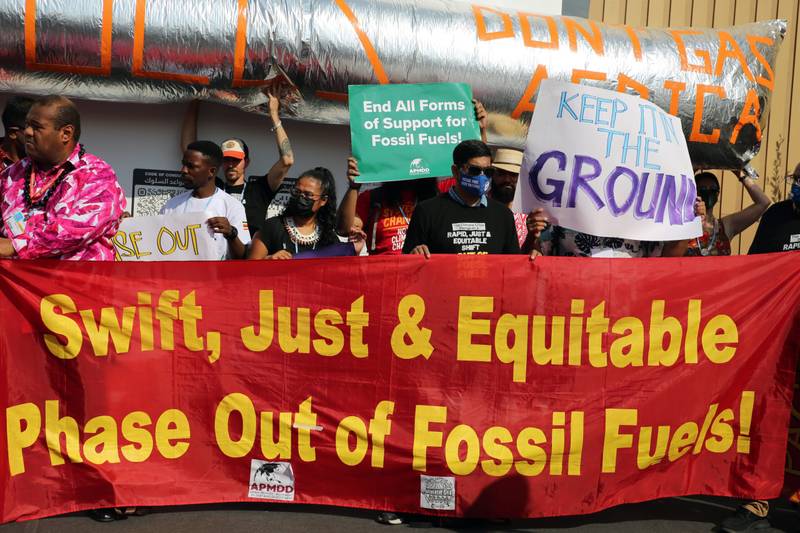22. November 2022Just Transition at COP27: Guiding Principle or Buzzword?
The UNFCCC’s 27th Conference of the Parties (COP27) has just concluded in Sharm El Sheikh, Egypt. In the UNFCCC context, the Just Transition principle was first formally recognized in 2015 and consequently included in the preamble of the Paris Agreement. Trade unions had strongly pushed for this. Since then, “just transition” has established itself worldwide as the norm for implementing the far-reaching transformation processes.

Photo by IISD/ENB | Mike Muzurakis
At COP27, “just transition” was all over the place, especially in the immense side events and pavilions space, which has become a climate change “trade fair” of sorts accompanying the intergovernmental negotiations. The International Labour Organisation even had a dedicated Just Transition Pavilion. Side events featuring aspects of transition abounded everywhere, to an extent that some people have started to use the term “just transition washing”. As the Climate Action Network put it in its daily “ECO” Newsletter: “This ‘jargonisation’ risks broadening it so that it is diluted and loses its meaning, or even that it becomes a ‘catch-all’ term used to describe any type of transition that just so happens to be convenient for a particular Party.”
But somewhat surprisingly, “just transition” made it also into the political space of the COP. In a last minute change, the Egyptian COP-Presidency included a mandate for the creation of a Just Transition Work Programme in the draft of the final text of the so-called Sharm-El-Sheikh Implementation Plan, the cover decision and main outcome of the conference. Last year at COP26, India famously included two last minute changes before the gavel came down for the Glasgow Climate Pact. The first is still on everyone’s mind: language about “phasing down” coal. The second much less so: Parties “recognizing the need for support towards a just transition”. During COP27 there were no public discussions about this aspect, at least until Egypt proposed the Just Transition Work Programme.
While the actual contents of the Just Transition Work Programme are to be spelled out in the coming months, international cooperation on just transition is already happening. The Just Energy Transition Partnership with South Africa (announced in Glasgow) and now Indonesia (announced at the G20 summit in Bali) are prime vehicles for this support. Other JETPs are currently being negotiated with India, Vietnam and Senegal. If these prove to be effective in leveraging finance for and implementing energy transformations, other countries are almost certain to follow that pathway. It makes sense to pool these experiences, extract lessons learnt and develop good practice guidelines.
From our work in CINTRAN there are several insights that we could provide to inspire and inform the Just Transition Work Programme:
- First, our empirical research shows that trying to define “justice” in just transitions positively is almost impossible. Yet, identifying concrete existing or anticipated injustices is much more tangible and enables constructive discussions. In that sense, a just transition could be defined as a process that alleviates or at least not exacerbates existing injustices and avoids or minimizes emerging injustices in the course of transformation.
- Such an injustice-focused approach could also help to operationalize a system to measure and evaluate progress against achieving a just transition. Such a metric is a key resource for ensuring the legitimacy of just transition measures and for reinforcing the trust of the donors financing those measures.
- Finally, a key research gap concerns the cost of just transition. So far, funding for just transitions supporting structural adjustments especially in the regions that host coal and carbon-intensive industries has for the most part not been provided on the basis of a systematic and science-based needs assessment. Rather, the volume of funding programmes was in most cases the result of political processes and reflected more a political price than actual costs. Many of the particularly affected regions are already worse off than the national average. Should we want to keep these regions at their current level to call just transition a success, or make sure that they actually catch up to the national average?
It is too early to know in what direction the Just Transition Work Programme will go. But what seems clear is that it should consider both theoretical and empirical research on transformation process in coal and carbon-intensive regions. CINTRAN and its sister projects ENTRANCES, TIPPING+ and TRACER can offer key lessons which can help to turn this opening in international climate policy into a useful and ultimately successful tool for international cooperation.
Author
Lukas Hermwille
Senior Researcher | Wuppertal Institute for Climate, Environment and Energy
Energy, Transport, and Climate Policy Division


Funding
The CINTRAN project has received funding from the European Union’s Horizon 2020 research and innovation programme under grant agreement No. 884539. The sole responsibility for the content of this website lies with the authors and does not necessarily reflect the opinion of CINEA or other EU agencies or bodies.